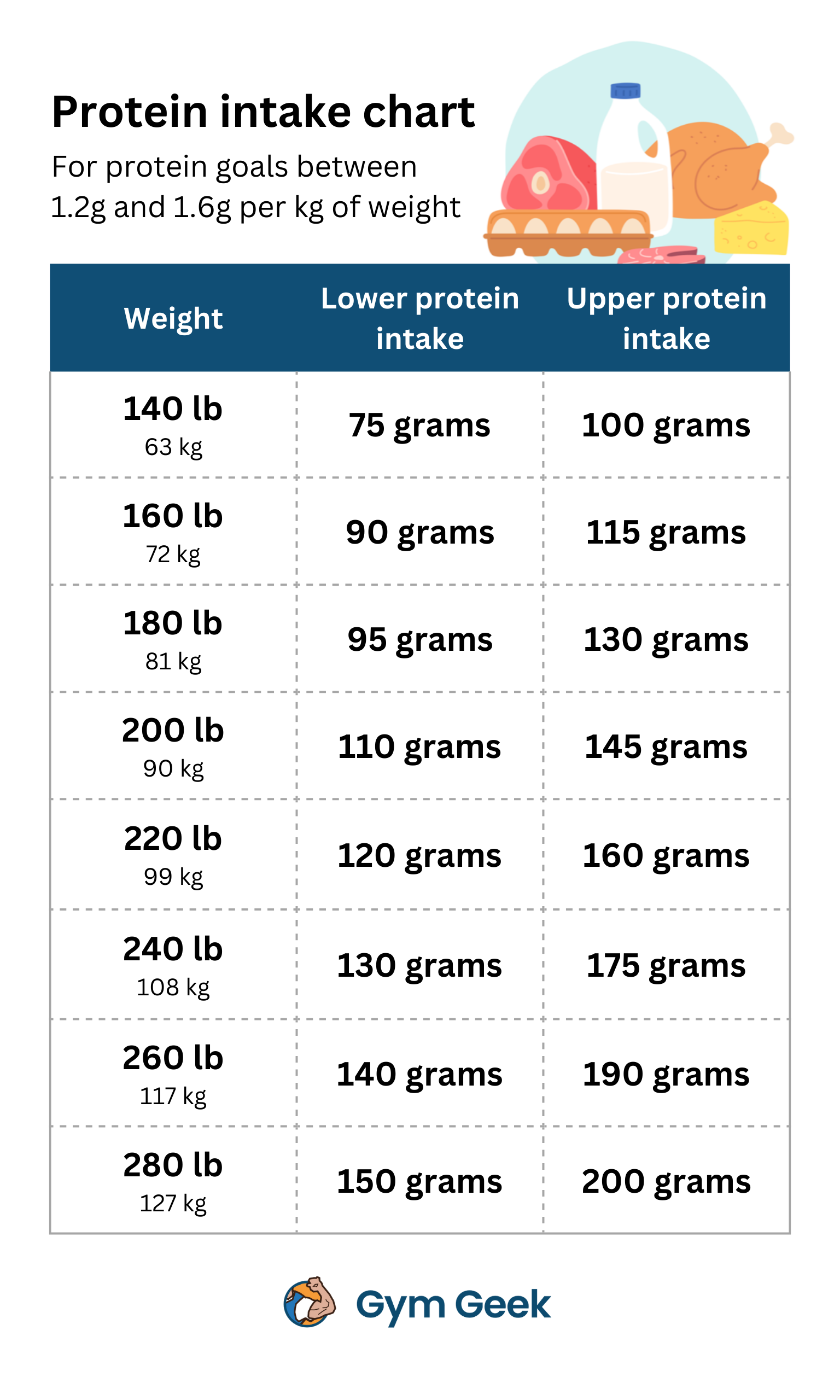| Ratio | Carbs | Fat | Protein |
|---|---|---|---|
51/30/19 Tailored ratio | — g per day | — g per day | — g per day |
50/30/20 Standard | — g per day | — g per day | — g per day |
40/30/30 Low carb | — g per day | — g per day | — g per day |
44/30/26 High protein | — g per day | — g per day | — g per day |
![]()
Most Popular Calculators
Calculators to try next:
Frequency asked questions
What is the macro calculator?
The macro calculator is a tool that breaks down your diet into popular macronutrient ratios. It takes into account your weight loss or weight gain goals, ensuring your macros hit the recommended intakes of carbs, proteins and fats.
Popular ratios include the 50/30/20 (Standard) and 40/30/30 (Low carb) ratios, as well as a tailored ratio based on your current weight and weight goal. There is also a high protein ratio that provides up to 1.8g of protein per kg of bodyweight.
What are macros?
Macros (short for “macronutrients”) are the nutrients your body needs to provide it energy. You need macros in large quantities – measured in many tens or hundreds of grams – compared against micronutrients, that are needed in trace amounts. The key macros when it comes to diet are carbs, fats and proteins.

Carbs are the body’s primary energy source, while proteins play a key role in tissue growth and repair. Fats also provide energy and help your body absorb other nutrients.
Macros are one key consideration when it comes to designing a healthy and balanced diet. For most people, a balanced diet consists of 40-65% carbohydrates, 20-35% fats and 10-35% proteins. These are wide ranges and the suitable ratio depends on your individual needs and health and fitness goals.
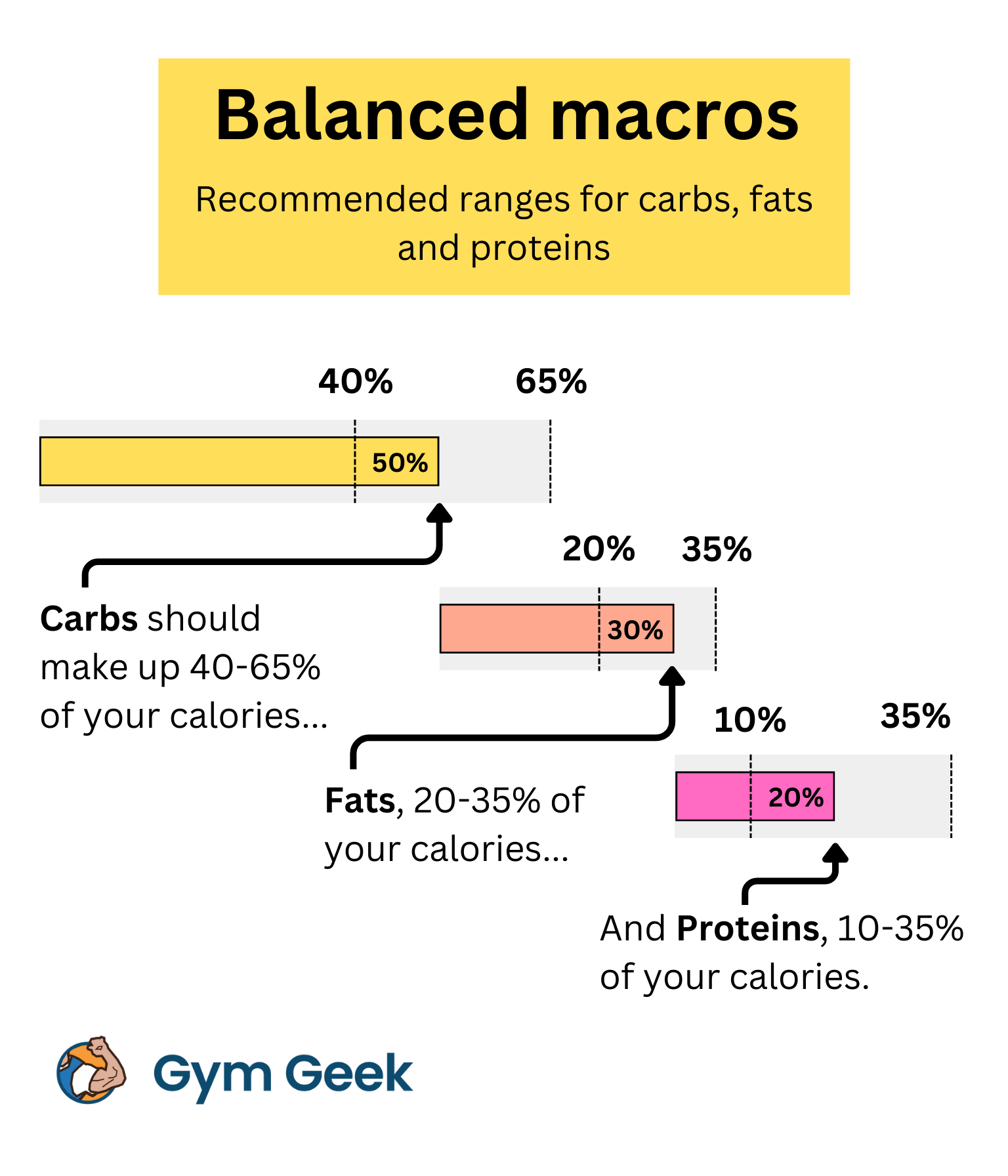
Micronutrients
Micronutrients are essential nutrients that your body needs in much smaller quantities. They include vitamins, minerals and trace metals and elements. Despite being needed in much smaller quantities, micronutrients are equally important for maintaining good health.
Vitamins are organic substances that our bodies cannot produce on their own, so we need to obtain them plants and animal foods in our diet. They play a critical role in your metabolism, the immune system and growth of muscle and other body tissue. Some common vitamins include Vitamin A, B, C, D, E and K.

Minerals are inorganic substances that are essential for good health. They include calcium, phosphorus, potassium, sodium, and magnesium and many other substances.
Finally, trace elements are those micronutrients that you need in even smaller amounts than vitamins and minerals. Examples include iron, copper, zinc, copper and iodine. Even though they needed in smaller quantities, they play a vital role in maintaining good health.
Proteins
Protein is an important building block for muscles and other body tissues. Your body uses protein to create and maintain new muscle cells, organ cells, skin and hair. Protein also plays a role in your immune system and can provide energy alongside the metabolism of carbs and fats.
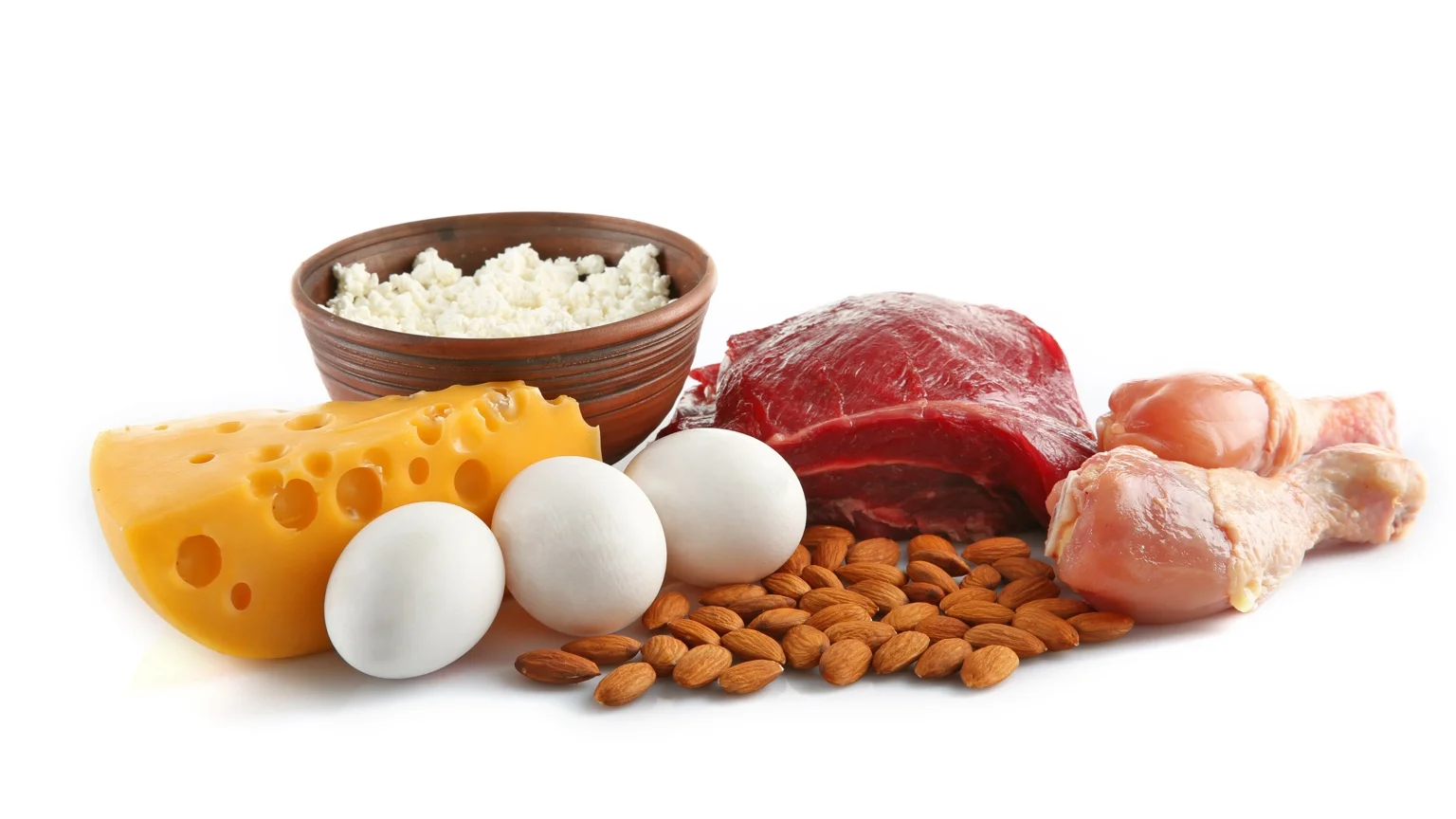
Proteins are made up of amino acids. There are 20 types of amino acid found in proteins in the human body. Nine of these proteins are called ‘essential’ amino acids, which means your body is unable to synthesize them. You must therefore get enough of these proteins from your diet.
Sources of protein
Good sources of protein include animal-based foods like meat, dairy and eggs. Good plant-based sources are beans, nuts and whole grains.
Animal-based foods high in protein:
- Beef
- Chicken
- Pork
- Fish
- Eggs
- Dairy, including cheese and milk
Plant-based foods high in protein:
- Legumes, including beans, lentils and chickpeas
- Whole grains, including quinoa and brown rice
- Nuts
- Seeds
- Spinach
- Broccoli
Many plant proteins are ‘incomplete’, which means they do not include all 9 essential amino acids. When following a plant-based diet, it’s important to eat a varied diet to ensure you can get proteins with all the essential amino acids.
Protein powder
Protein supplements can be a convenient source of protein, but for most people it is not necessarily to take a supplement. A diet rich in meats, dairy, legumes and nuts can provide all the protein you need.

Some people may benefit from protein supplements in certain circumstances. Athletic individuals or those with high levels of physical activity need more protein to support muscle growth and repair. To meet the increased demand for protein, it may be helpful to take a supplement.
Recommended intake of protein
Protein is essential for growth, maintenance and repair of body tissue. The amount of protein you need depends on your age, gender, weight and level of physical activity. Consuming too much protein can be harmful to your health, and may cause kidney damage, osteoporosis and other health issues.
For most people, it is recommend to consume 0.8 grams of protein per day for each kg of bodyweight. For a person weighing 70 kilograms, this means the recommendation is 56 grams of protein per day. Factors such as physical activity level, muscle mass, and health conditions may require an individual to consume more protein.
Our calculator uses a protein intake of between 1.2g and 1.8g per kg of bodyweight.
Carbohydrates
Carbohydrates (carbs) provide your body with glucose, that is converted to energy to fuel your body. Your body stores glucose as glycogen in your liver and muscles.

There are two main types of carbs – simple and complex. Simple carbs are made up of one or two sugar molecules and are found in fruits, honey and milk, for example. Processed foods tend to contain a lot of simple carbs.
Complex carbs are made up of complex chains of sugar molecules and can be found in whole foods and vegetables. Because your body has to break down complex carbs, they provide more sustained energy.
Starch is a type of carbohydrate that is found in grains, potatoes and legumes, and is broken down into glucose to provide energy to your body.
Fiber is a non-digestible carbohydrate that is essential for maintaining a healthy digestive system. Fiber in your diet can help regulate your bowel movements, promote satiety (feeling of fullness) and can help control your blood sugar level.
Sources of carbohydrates
Good sources of complex carbohydrates include:
- Whole grains
- Vegetables
- Quinoa
- Brown rice
- Sweet potatoes
- Oatmeal
- Bananas
Recommended intake of carbohydrates
It is generally recommended that 40-65% of your diet, measured by calories, comes from carbohydrates.
Fats
There’s a common misconception that fats are unhealthy and should be avoided. In fact, our bodies need fat to be healthy and function efficiently.

There are three types of fat:
- Saturated fats: Some people know these as the ‘unhealthy fat’. A diet that is high in saturated fats is associated with an increased risk of high cholesterol. This may lead to heart disease.
- Unsaturated fats: Unsaturated fats are healthy fats that provide essential fatty acids to your body. These can be monounsaturated or polyunsaturated fats.
- Trans fats: Trans fats are a harmful type of fat that should be avoided. They have no nutritional value and can increase the risk of heart disease, stroke and diabetes.
Fats play a few key roles in your body. Firstly, they are energy dense, containing more ‘calories’ of energy per gram, compared against both carbohydrates and proteins. If you consume more calories than is needed, the excess is stored as fat. These reserves can be broken down later when your body requires additional energy.
Fat is also important for absorbing many vitamins. Vitamins A, D, E and K are known as “fat-soluble” vitamins, which means they can only be absorbed into the body when the food you eat contains fat.
Sources of fats
Foods high in “good fats” (unsaturated) include:
- Avocados
- Nuts
- Seeds
- Olive oil
- Fatty fish
Foods high in “bad fats” (trans and saturated fats) include:
- Processed and ultra-processed foods
- Fried foods
- Baked goods
Recommended intake of fats
It is generally recommended that 20-35% of your diet, measured by calories, comes from fat. You should limit your intake of saturated and trans fats.
Macros and calories
Whether you are looking to lose weight, gain weight or maintain your existing weight, it’s important to understand your BMR (Basal Metabolic Rate) and TDEE (Total Daily Energy Expenditure) when planning your diet. Your TDEE is an estimate of the number of calories you burn each day. To lose weight, you can eat fewer calories relative to your TDEE; and to gain weight, you can eat more calories.
You can think of your daily calorie intake as made up of the 3 macronutrients – carbs, fats and proteins. Each macronutrient provides a number of calories per gram:
- Carbohydrates – 4 calories per gram
- Fats – 9 calories per gram
- Proteins – 4 calories per gram
Fats are more than twice as energy-dense when compared to carbohydrates and proteins.
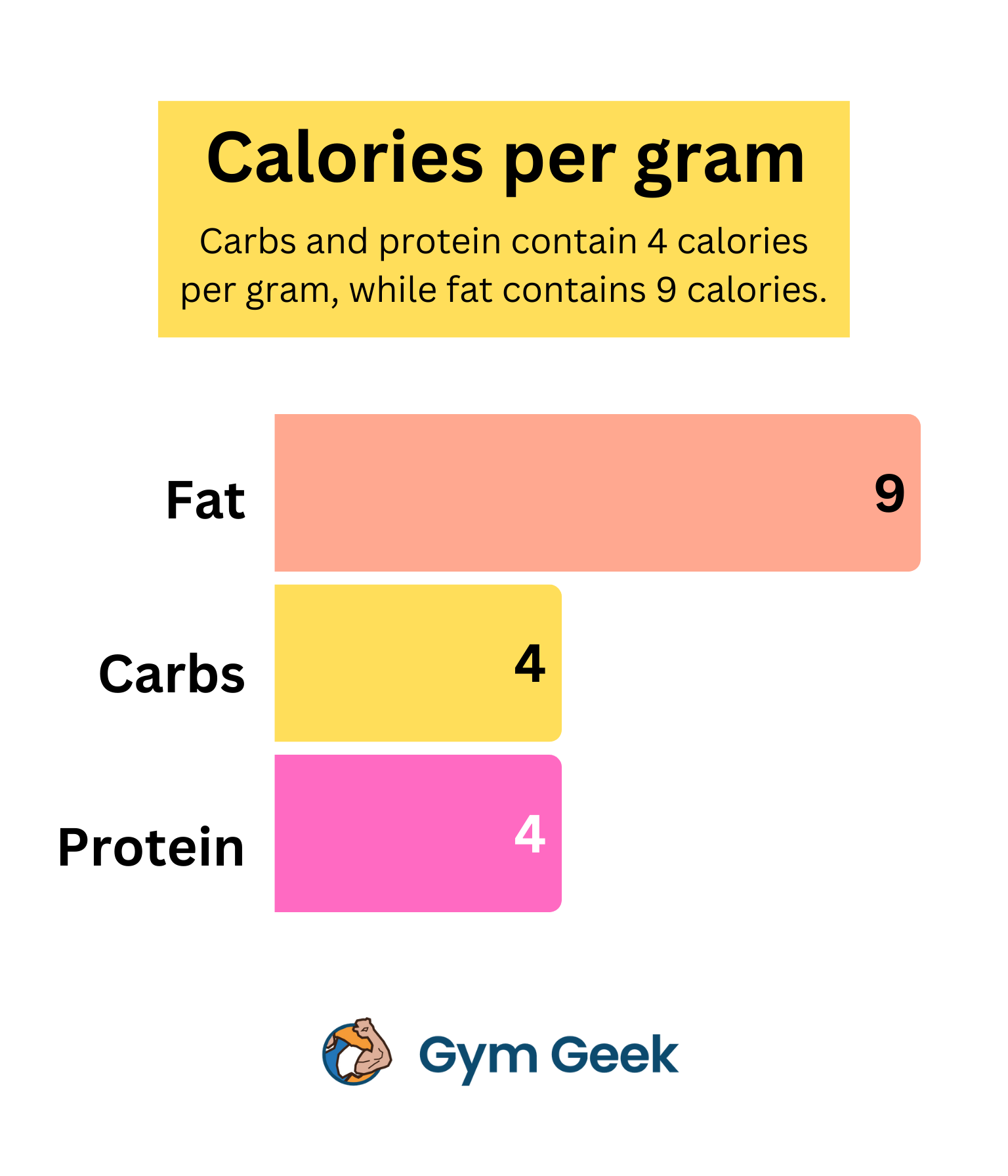
A macro ratio is the proportion of calories that each macro represents in your diet. For example, a 50/30/20 macro ratio means that 50% of your calories come from carbohydrates, 30% come from fats and 20% come from proteins. Remember that the ratio is a proportion of calories, not a proportion of weight (grams) of the food you eat.
For each macro ratio, the macro calculator outputs the number of grams per day for each of carbohydrates, fats and proteins. For example, if you eat 2,000 calories per day with 20% of your calories coming from protein, this means you will each 400 calories of protein. Divide this by 4 to get 100 – and this is the amount of protein you should eat per day on this ratio: 100g per day.
How does the macro calculator work?
First, input the information about your weight, height, gender, age and activity level. This will be used to calculate your TDEE. By default, the calculator assumes you are maintaining your current weight. But you can enter a weight loss goal or weight gain goal of up to 1 kg (2.2 lb) per week.
Using your TDEE along with your weight goal, the macro calculator will output a daily calorie consumption estimate. This includes a calorie deficit or a calorie surplus. See our calorie calculator guide for more information on how this calculation works.
The calculator will output up to 4 macro ratio breakdowns:
- Tailored macro ratio – A ratio that provides between 1.2 g and 1.6 g of protein per kg of bodyweight. It also ensures a minimum fat intake based on your bodyweight.
- High protein macro ratio – A similar ratio to the tailored macro ratio, except it provides between 1.6 g and 1.8 g of protein per kg of bodyweight.
- Standard macro ratio – The standard 50/30/20 ratio that is a good starting point for many people of a healthy weight.
- Low carb macro ratio – A 40/30/30 ratio that reduces the amount of carbs and increase the amount of protein in your diet.
Minimum calories
The calculator will not allow your daily calorie estimate to fall below 1,200 calories per day for women and 1,500 calories per day for men. A diet that consumes fewer than this is not safe for most people.
Which activity level should I choose?
Our macro calculator estimates your TDEE based on your current weight and activity level. The activity levels are called Harris-Benedict Standard Activity Factor (SAF) scores, and they range from 1.2 (+20%) to 1.9 (+90%), depending on your level of physical activity.
To estimate your TDEE, you will need to determine which SAF score fits your lifestyle best:
- Sedentary (SAF = 1.2) – Your daily life involves little to no exercise. You may work a desk-based job and spend your spare time indoors with little physical activity.
- Light Activity (SAF = 1.375) – You take part in light exercise or sports 1-3 days per week. If you work in a job where you spend time on your feet for most of the day, this may be an appropriate factor.
- Moderate Activity (SAF = 1.55) – You take part in moderate exercise or sports 3-5 days per week. This can include activities like jogging, cycling or swimming for at least 30 minutes each day.
- Very Active (SAF = 1.725) – You take part in moderate-to-vigorous exercise or sports 6-7 days per week. This can include running or playing competitive sports.
- Extra Active (SAF = 1.9) – You take part in vigorous training two times a day or have job requiring hard physical labor.
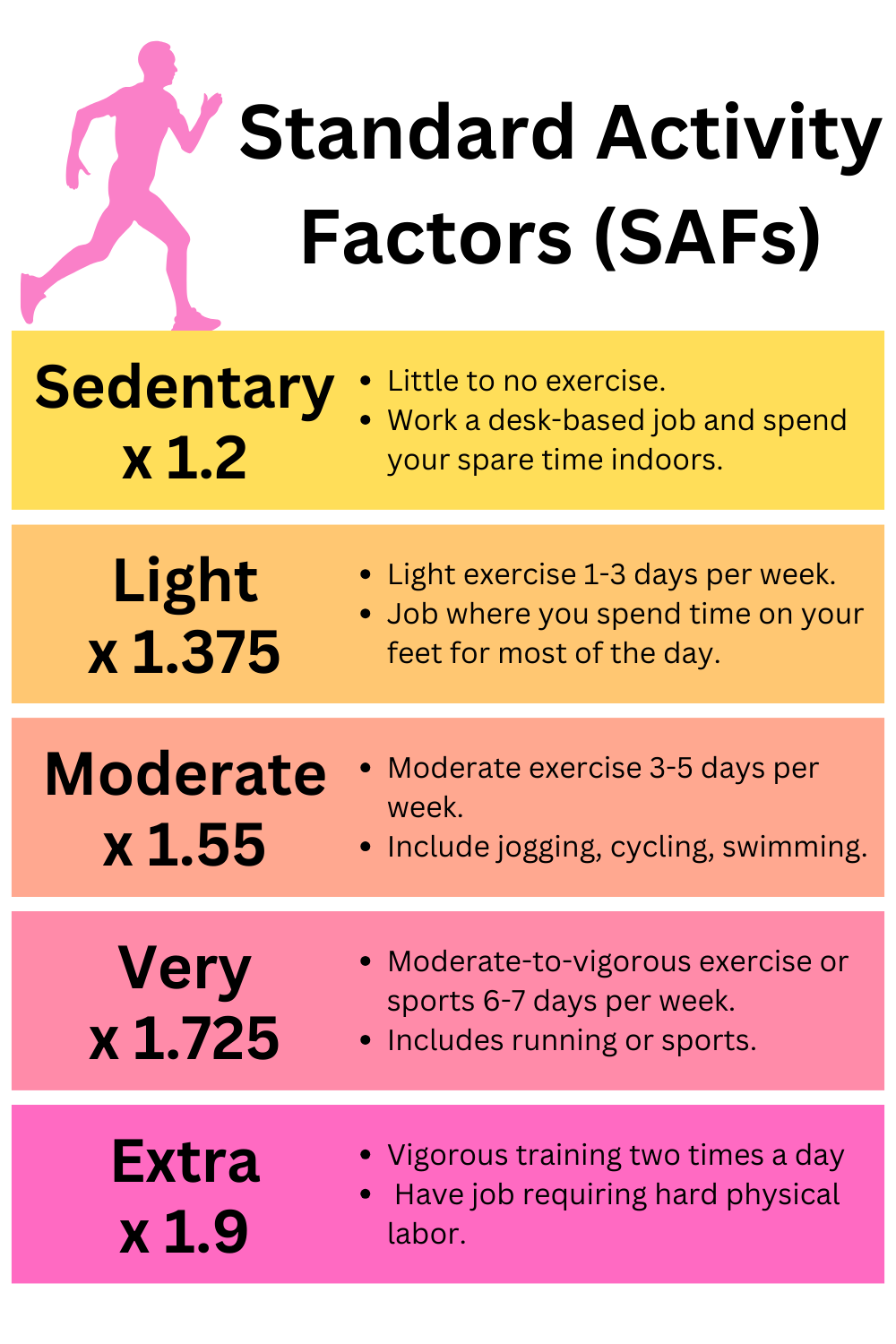
Tailored macro ratio
A ratio that provides between 1.2 g and 1.6 g of protein per kg of bodyweight. It also ensures a minimum fat intake based on your bodyweight.
Protein
If you have a sedentary activity level or are aiming to lose weight, the tailored macro ratio defaults to 1.2 g of protein for each kg of bodyweight. If you are not sedentary and looking to maintain or gain weight, the ratio will provide 1.6 g of protein for each kg of bodyweight.
The calculator will cap the protein proportion to 35% of the ratio to avoid an overconsumption of protein.
Fat
In most cases, the tailored macro ratio will provide 30% of your daily calorie intake to fats. However, it will adjust your fat intake down to keep your carbohydrate intake to at least 40% of your diet. It will never fall below the absolute minimum consumption of 0.5 g of fat per kg of bodyweight. This level provides the essential fatty acids for cell growth, nutrient absorption and hormone production.
The fat level is likely to reduce from 30% if you have a low bodyweight or are following an aggressive weight loss plan. The macros may not meet the nutritional guidelines for carbohydrate, fat and protein intake.
Carbs
Once the calculator has established the acceptable intake of proteins and fats, the remaining calories are allocated to carbohydrates.
High protein macro ratio
A similar ratio to the tailored macro ratio, except it provides between 1.6 g and 1.8 g of protein per kg of bodyweight.
Protein
If you have a sedentary activity level or are aiming to lose weight, the high protein macro ratio defaults to 1.6 g of protein for each kg of bodyweight. If you are not sedentary and looking to maintain or gain weight, the ratio will provide 1.8 g of protein for each kg of bodyweight.
The calculator will cap the protein proportion to 35% of the ratio to avoid an overconsumption of protein.
Fat
Just like the tailored macro ratio, the high protein macro ratio will provide 30% of your daily calorie intake to fats. However, it will adjust your fat intake down to keep your carbohydrate intake to at least 40% of your diet. It will never fall below the absolute minimum consumption of 0.5 g of fat per kg of bodyweight. This level provides the essential fatty acids for cell growth, nutrient absorption and hormone production.
The fat level is more likely to reduce down compared to the tailored macro ratio. This is because neither ratio will adjust down your protein intake to satisfying the nutritional requirements of fats or carbohydrates.
Carbs
Once the calculator has established the acceptable intake of proteins and fats, the remaining calories are allocated to carbohydrates.
Standard macro ratio – 50/30/20
The 50/30/20 rule-of-thumb is a popular macro ratio. According to this rule, 50% of your daily calories should come from carbohydrates, 30% from proteins, and the remaining 20% from fats. This ratio is simple, but it may not suit every individual. It provides a reasonable starting point for those looking to structure their diet for healthier living.
Low carb macro ratio – 40/30/30
The low carb macro ratio follows a 40/30/30 split between carbs, fats and proteins. 40% of your daily calorie intake should come from carbohydrates, 30% from proteins and the remaining 30% from fats.



